Bits and Pieces
GOOD: Recommended by Tim Ferriss – an essay in three parts by Chimamanda Ngozi Adichie, a Nigerian author whose books include We Should All Be Feminists. Ferriss says: “Everyone should read this essay. It’s a taste of things to come on a much larger scale. Social media will breed more of this, and few people are immune.” Click here.
BAD: On September 29, the National School Boards Association (NSBA), which represents more than 90,000 school boards in the US, called on the Biden administration to “protect its members” from “angry mobs” of parents who have been attending school board meetings and objecting to mask mandates for children, pornographic content in grammar school libraries, and the teaching of critical race theory in class. They argued that such parents were guilty of hate crimes and should be considered domestic terrorists, and asked that federal agencies such as the FBI, the Secret Services, and the Departments of Justice and Homeland Security “investigate, intercept, and prevent the current threats and acts of violence” by whatever “extraordinary measures” necessary.
The Biden administration must have thought that was a terrific idea. The very next week, the president instructed the Justice Department to employ the FBI and other agencies to get to work. Click here.
QUESTIONABLE: Amazon Studios has mandated a hiring cap on white actors and production staff for its movies and streaming shows. This is part of a general effort to diversify its employees and provide more opportunities for people of color and other minorities. As a result, program producers are now required to list the races, ethnicities, and genders of all cast and crew.
David Cole, a contributing columnist to Taki’s Magazine, posed as a producer to ask the company leadership: “In what column do I put my Jewish actors and crew? Are they in the white column, and therefore part of the capped talent, or are they in the nonwhite column, therefore counting toward the mandated quota?”
That was more than a month ago. So far, he’s gotten no response.
GOOD: Female student athletes fight back against the Woke mob pushing transgender competitors in biological women’s sports. Click here.
BAD: Is this the sort of person we want in charge of our banking system? Click here.
BRAVE: Alpha male tennis legend stands his ground. Click here.
Where are the workers? Where are the men?
DS, a friend, is the CEO of a substantial restaurant chain. Last week, she sent me a note explaining how her business, like almost all restaurant businesses, is suffering due to a lack of workers. “With rates of pay sky high, unprecedented benefits, and $1,000 signing bonuses,” she wrote, “I am at a loss when it comes to helping my company get back in the black.”
The COVID shutdown and government bailout and bribery programs that followed are to blame for the fact that tens of millions of Americans are not currently interested in working. That will change as these programs close. But what won’t likely change is something more sinister: a rising sense of income entitlement among young people, and among young men in particular.
Too many young people today don’t feel an obligation to take care of their financial responsibilities, including paying their bills and their debts. They don’t feel morally bound to earn an income. If they can find a meaningful job that can satisfy their “passions,” they will work – so long as the requirements aren’t too demanding. But if they can’t find such a job, they don’t feel like they should work.
In her note to me, DS attached a report on the US labor situation that contained a startling fact: 30% of all working-age men in America aren’t working. This is both amazing and disturbing. Think about it: 1 out of every 3 working-age men in the US is not working.
And here’s another fact: This trend – fewer working-age males working – has been going on for more than 70 years. The participation rate for men in the US workforce peaked in 1949 at 87.4%, and has been dropping steadily ever since. It now stands at 67.7%.
6 Engineering Marvels That Changed History
I thought this was interesting – from the History Channel website…
- Transcontinental Railroad
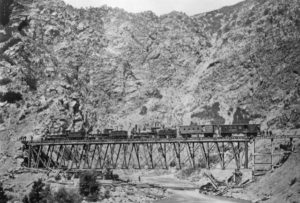
View of construction of the Union Pacific section of the Transcontinental Railroad across Devil’s Gate Bridge, Utah, 1869 (PhotoQuest/Getty Images)
While the Civil War was still raging in the East, work began in the West to build a railroad that would link the United States from coast to coast. Authorized by the 1862 Pacific Railroad Act, the Central Pacific Railroad Company laid tracks eastward from Sacramento, California, while the Union Pacific Railroad Company moved west from Omaha, Nebraska. The railway facilitated the country’s westward expansion by cutting cross-country travel times from months to under a week. READ MORE
- New York and Boston Subways
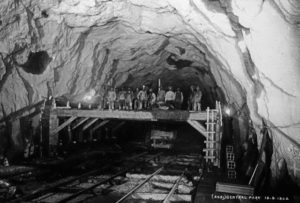
Construction workers in a tunnel of the New York City subway, (Philippe Clement/Arterra/Universal Images Group/Getty Images)
With horse-drawn carriages clogging the streets of New York City and Boston and elevated trains raining soot down on pedestrians, civic leaders sought a transportation alternative that was faster and cleaner. They turned to a radical solution – underground train travel, which many Americans viewed as impractical and dangerous. Boston opened the first American subway in 1897. New York followed seven years later. Both cities employed a cut-and-cover construction method to minimize disruption to city life. With the world’s first subway in London still using steam-powered locomotives, the American systems differed in employing electrically powered trains. The advent of rapid transit redefined Boston, New York and American cities to follow.
- Panama Canal
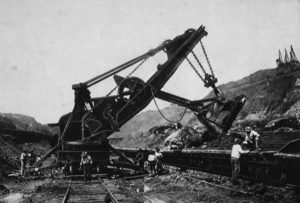
A shovel vehicle operates during the construction of the Panama Canal, c. 1906 (Hulton Archive/Getty Images)
Linking the Atlantic and Pacific Oceans, the 51-mile Panama Canal transformed global trade routes when it opened in 1914. After a failed attempt by the French in the 1880s, the United States tried again in 1904, jettisoning the earlier design from a sea-level canal for one that used locks and damned up the Chagres River to create the world’s largest man-made lake at the time. Ten percent of the 56,000 workers who toiled on the project between 1904 and 1913 died. Perhaps the most remarkable feat? The international ship channel was completed on time and on budget. READ MORE
4. The Golden Bridge
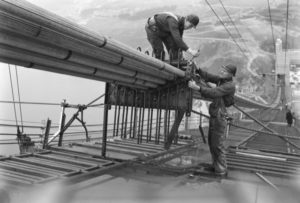
Workers on the catwalks bundling the cables during the construction of the cables of the Golden Gate Bridge in San Francisco, California, c. 1936 (Underwood Archives/Getty Images)
The world’s longest suspension bridge for 27 years after its 1937 opening, the 1.7-mile Golden Gate Bridge soars above the nearly 400-foot-deep strait connecting San Francisco Bay and the Pacific Ocean. Containing enough cable to circle the globe three times, the bridge can move more than two feet laterally to withstand the strait’s strong winds. Chief engineer Joseph Strauss prioritized safety by putting a safety net beneath the bridge that saved the lives of 19 workers. READ MORE
5. Hoover Dam
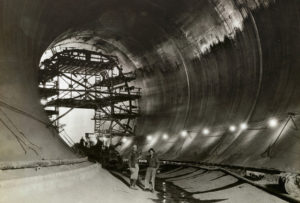
View inside one of the 50-foot-high Hoover Dam concrete tunnels, showing the grouting process in operation in Diversion Tunnel No. 4, through which the Colorado River would be diverted (George Rinhart/Corbis/Getty Images)
Built by an army of more than 21,000 workers, the 60-story-tall Hoover Dam was the world’s largest concrete structure and highest dam at the time it was dedicated in 1935. The project, which required the Colorado River’s diversion through four excavated tunnels, finished two years ahead of schedule. The arch-gravity dam on the Arizona-Nevada border controls the flow of the Colorado River, stores enough water to irrigate 2 million acres and powers more than 1 million homes with hydroelectricity and propelled the development of cities such as Las Vegas and Phoenix and created Lake Mead, the largest reservoir in the United States in terms of water capacity. READ MORE
- Interstate Highway System
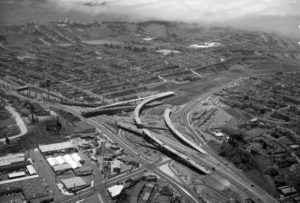
Aerial photo of San Francisco, c. July 1959, showing the Highway 101 and Interstate 280 interchange still under construction (Duke Downey/San Francisco Chronicle/Getty Images)
President Eisenhower spearheaded passage of the Federal-Aid Highway Act of 1956, which authorized the construction of 41,000 miles of expressways with controlled ramp-based access and no at-grade intersections. This was at the time the largest public works project in world history. The Interstate Highway System transformed the American economy and way of life by spurring the growth of suburbs while also decimating certain urban neighborhoods. READ MORE
Personal Productivity Advice From F. Scott Fitzgerald
One of the most important lessons I ever learned about personal productivity was that I could accomplish much more if I spent the first hour or two of my day focusing on my goals that were truly important. I was surprised to discover recently that none other than F. Scott Fitzgerald had given the very same advice to his daughter in a letter he wrote to her on April 18, 1938:
If you will trust my scheme of making a mental habit of doing the hard thing first, when you are absolutely fresh, and I mean doing the hardest thing first at the exact moment that you feel yourself fit for doing anything in any particular period, morning, afternoon or evening, you will go a long way toward mastering the principle of concentration.
3 Words I’m Trying to Work Into My Conversations
* profligacy: extravagance
* pusillanimous: cowardly
* cynosure: focus
From Michael Masterson…
When deliberating any important decision, ask yourself 4 questions:
* What is the best possible outcome?
* What is the worst?
* Would I be happy with the best outcome?
* Could I live with the worst?
